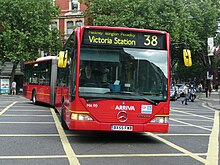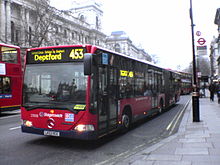Main article: Articulated buses in the United Kingdom





Articulated buses, popularly called "bendy buses," were introduced to London in October 2001 when two Wright Eclipse Fusion bodied Volvo B7LAs were hired from First Hampshire & Dorset, one of which was repainted into First London's red livery, and six Wright Fusion bodied Volvo B10LAs from First Glasgow for a trial on route 207 between Shepherd's Bush and Hayes-By-Pass.
In June 2002, new Mercedes-Benz Citaro O530Gs were introduced on Red Arrow services 507 and 521. While articulated bus operation had been standard in several other countries for over 20 years, their use in the United Kingdom had been limited, with their introduction in London gaining a lot of press attention. They were later introduced on routes 12, 18, 25, 29, 38, 73, 149, 207, 436 and 453, which were among the busiest routes of the TfL bus network.
During the 2008 mayoral campaign, victorious Boris Johnson pledged to withdraw articulated buses on the grounds that they were unsuitable for London, and to introduce a modern version of the AEC Routemaster. Withdrawals began in July 2009, when articulated buses on routes 38, 507 and 521 were replaced with conventional single and double decker buses, and a prototype for the New Routemaster was promised to be on the streets by 2012. The last articulated buses were withdrawn in December 2011.
Background
| This section needs additional citations for verification. Please help improve this article by adding citations to reliable sources in this section. Unsourced material may be challenged and removed. (December 2014) (Learn how and when to remove this message) |
Articulated buses were introduced on several high-capacity routes in the 2000s, coinciding with withdrawal from passenger service of the AEC Routemaster. The Routemasters, involving a step upwards and poor accessibility did not conform to the Disability Discrimination Act 1995. There was also the risk of litigation over accidents involving the Routemaster's rear open platform.
Articulated buses with multiple doors and simultaneous boarding arrangements were capable of loading passengers in less time than conventional double decker buses and Routemasters. They had a much higher passenger capacity, being able to carry over 140 people per vehicle compared to 77 in a Routemaster, although with far fewer seats. The low-floor design of the buses also improved access for disabled people.
Articulated buses took up more road space per vehicle (18 metres compared to 9.1 metres for a Routemaster and 10 metres for a double decker), although in terms of road surface used per passenger, there was little difference between double decker buses (which stack passengers vertically on two floors) and articulated buses – 11.8 cm road surface length per Routemaster passenger against 12.8 cm per articulated bus passenger: 8.7% more.
The increased vehicle size meant they were more likely to block junctions and cause difficulties for other road users. Press coverage regarding cyclists and motorcyclists was generally negative due to the reduced viewpoint of the driver and greater likelihood of cyclists to enter blind spots.
The routes converted to articulated bus operation were:
| Route | Commenced | Ceased | Operator | Replaced by |
|---|---|---|---|---|
| 12 | 6 November 2004 | 4 November 2011 | London Central | double decker buses |
| 18 | 15 November 2003 | 12 November 2010 | First London | double decker buses |
| 25 | 26 June 2004 | 24 June 2011 | East London | double decker buses |
| 29 | 14 January 2006 | 25 November 2011 | Arriva London | double decker buses |
| 38 | 29 October 2005 | 13 November 2009 | Arriva London | double decker buses |
| 73 | 4 September 2004 | 2 September 2011 | Arriva London | double decker buses |
| 149 | 24 April 2004 | 15 October 2010 | Arriva London | double decker buses |
| 207 | 9 April 2005 | 9 December 2011 | First London | double decker buses |
| 436 | 8 February 2003 | 18 November 2011 | London Central | double decker buses |
| 453 | 15 March 2003 | 23 September 2011 | Selkent London General (1) |
double decker buses |
| 507 | 5 June 2002 | 24 July 2009 | London General | single decker buses |
| 521 | 5 June 2002 | 31 August 2009 | London General | single decker buses |
(1) Route 453 transferred from Selkent to London General on 16 February 2008 after tender renewal
Incidents
Fires
During the initial stages of deployment of the articulated buses, between December 2003 and March 2004 there were three similar fires on the new Mercedes-Benz Citaro buses, causing concern over the possibility of an in-built risk to the public. In one incident, a bus caught fire on its delivery route to its operator. The fires caused the temporary withdrawal and modification of the entire fleet of 130 buses.
The buses were brought back into service after engineers replaced and modified problematic pipework in the bus engines. A later fire was ruled out as unconnected. The problem resurfaced with ex Arriva London buses in Malta in August 2013.
Increased fare evasion
The introduction of articulated buses increased fare evasion as passengers were able to enter through any door, leading to the buses becoming known to Londoners as "The Free Bus". On other UK buses (including articulated buses outside London), entry is only permitted via the front entrance, which is monitored by the driver and thus discourages evasion. As a result, Transport for London recruited an extra 150 Revenue Protection Inspectors to police revenue collection. In 2006 it was reported that conventional buses (i.e. single and double-deckers) accounted for £3,636 of fare evasion in a year, compared to articulated vehicles at £6,333 per year.
Campaign issue
In September 2007, Boris Johnson, the Conservative Party candidate for the 2008 Mayor of London elections, said that his first act as mayor of London would be to "scrap" articulated buses and replace them with a "modern-day AEC Routemaster" with an open rear platform and a conductor. The New Routemaster first entered service in February 2012.
Withdrawal

In August 2008, following the election of Boris Johnson as Mayor of London, it was announced the articulated buses would be withdrawn as their five-year operating contracts expired, starting from May 2009, and completed by 2013 (or 2015 depending on contract extensions). This was brought forward to December 2011.
Research by London TravelWatch indicated that such a withdrawal could prove costly to TfL. A study conducted in September 2008 found that replacing articulated vehicles on routes 38, 507, and 521, whilst maintaining overall route capacity, would cost an additional £12.6m per annum, due to the additional vehicles necessitated. Additional cost was also incurred with the need to pay early termination fees on leases.
The first articulated vehicles to be replaced were on routes 507 and 521, which were replaced by twelve-metre long single-deck buses in July and September 2009 respectively. Articulated buses were replaced by double-deckers on route 38 in November 2009. Route 207 was the last route to operate articulated buses on 10 December 2011.
Withdrawn buses have found their way to other parts of the UK. Some went to Arriva Midlands in Leicester and Arriva North West in Liverpool. Go-Ahead Group transferred some to its Brighton & Hove, Go North East and Go South Coast divisions. Some were sold to CT Plus, Bristol and McGill's Bus Services, Glasgow. Arriva also exported 81 to Malta in 2011 for use by its Arriva Malta subsidiary.
One articulated vehicle, MAL15 from the Red Arrow batch, has been preserved by the Bromley Bus Preservation Group.
See also
- Articulated bus
- Articulated buses in the United Kingdom
- Buses in London
- List of bus types used in London
References
- 'Innovative' bendi buses BBC News 8 October 2001
- ^ Wharmby, Matthew (2016). The London Bendy Bus. Pen & Sword. pp. 8–11. ISBN 978-1-78383-172-2. Retrieved 18 October 2021.
- London transport - with a twist BBC News 5 June 2002
- London gets first cash-free bendy buses Transport for London 5 June 2002
- Tahir, Tariq (22 March 2004). "'Bendy bus' safety fears". Evening Standard. Retrieved 13 June 2011.
- Firebreathing buses threaten London The Register 24 March 2004
- "What happened to London's bendy buses 10 years after being kicked out". 9 December 2021.
- ^ Scrap the bendy bus and bring back Routemasters, says Boris Evening Standard 11 September 2007
- "The beginning of the end for the bendy bus" (Press release). Greater London Authority. 5 December 2008. Archived from the original on 7 December 2008.
- A New Bus for London – Next steps Transport For London
- ^ "Bendy bus makes final journey for Transport for London". BBC News. 9 December 2011. Archived from the original on 9 December 2011.
- Webster, Ben (19 March 2003). "Routemasters put on road to retirement". The Times. ISSN 0140-0460. Retrieved 16 June 2022.
- "Thousands bid adieu to Routemaster bus". Spokesman Review. 10 December 2005. Retrieved 27 August 2021.
But there were a few dissenters who turned out Friday, including disability rights protesters who held placards saying: "Routemaster good riddance."
- ^ Doubts over future of bendy buses (Television production). London Tonight, ITN. 1 March 2006. Retrieved 25 April 2024.
Critics argue that on too many occasions the 18 metre vehicle just gets in the way ... For some users though bendy buses are a dream, offering a real boost to their mobility around the capital
- ^ Barney, Katharine (2 October 2007). "New bendy bus blaze scare". Evening Standard. Retrieved 13 July 2013.
- "Bendy-buses withdrawn after fires". BBC News. 24 March 2004. Retrieved 7 January 2007.
- Third Arriva bus to catch fire within three days Malta Today 27 August 2013
- Tourists visiting Malta driven round the bend by the unpopular buses that Boris Johnson rejected The Independent 16 September 2013
- "London fare dodgers 'cost £30m'". BBC News. 24 May 2006.
- "Call for crackdown on bendy bus fare dodgers". The Guardian. London. 25 May 2006.
- "Bendy buses taken out of service". BBC News. 24 July 2009. Archived from the original on 27 July 2009.
- Buses issue 641 August 2008 page 5
- "Consultation on Articulated Bus Routes 38, 507 and 521 (sec. 4.8.1)". London TravelWatch. Archived from the original on 4 March 2009. Retrieved 30 September 2008.
- Final bendy buses banished from London Greater London Authority 9 December 2011
- London's Bendy Buses to be Sent to Malta Archived 3 December 2013 at the Wayback Machine LBC 7 December 2011
- London's old buses are driving Maltese round the bend The Guardian 13 December 2011
- Were bendy buses sold cheaply? Times of Malta 26 February 2014
External links
| Articulated bus routes in London | |
|---|---|